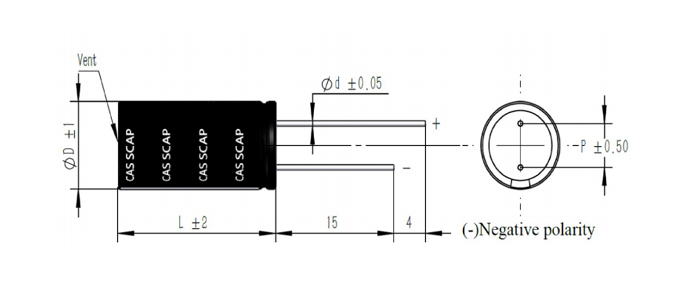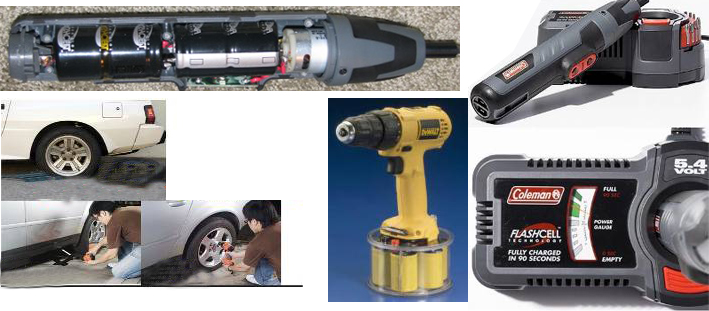Consulting phone:
135-3037-2041
(Mr.Wang)
Product introduction:
The super capacitor battery is also called gold capacitor or farad capacitor. It stores energy through polarized electrolyte and belongs to a kind of double layer capacitor. Because the process of energy storage does not take place chemical reaction, the energy storage process is reversible, because the supercapacitor can be repeatedly charged and discharged hundreds of thousands of times. Super capacitors generally use activated carbon electrode materials, which have the characteristics of large adsorption area and more electrostatic storage, and are widely used in new energy vehicles.
Series Specification Sheet:
Specification | characteristic | |||||||
Rated voltage V R | 2.7V.DC | |||||||
surge voltage | 2.85V.DC | |||||||
Capacity range | 1F-120F | |||||||
Operating temperature range | -40℃~+65℃ | |||||||
Product life | Normal temperature cycle life: At 25°C, the capacitor is charged and discharged 1 million times between the specification voltage and the half-rated voltage with a constant current. Capacity attenuation ≤30% times, internal resistance change ≤2 times | |||||||
High temperature endurance life: under the condition of +65℃, the rated voltage is applied for 1000 hours. Capacity attenuation 30%, internal resistance change ≤2 times | ||||||||
Product performance table:
Product number | Forehead Certainly Electricity Voltage (V) | Nominal capacity ( F) | Product ruler inch mm | Internal resistance | Working current | peak value Electricity stream (A) | Leakage current (72hrs /µA) | can quantity (IN. h) | Energy Density (W.h/kg) | functional density (Kw / kg) | |
Outer diameter (D) | high Degree (L) | ESRA C(25℃/mΩ) | (A) | ||||||||
YKY2R7V705C06DSZ | 2.7 | 5 | 8 | 25 | 80 | 0.65 | 3.07 | 12 | 0.0051 | 2.18 | 2.03 |
Dimensions:

Application field: electric tools
Cordless electric screwdriver – charging for 90 seconds
The product is mainly aimed at amateur users who do not use it for a long time, but need fast electricity and sudden large use
22 screws can be installed when fully charged, and 37 screws can be installed with battery
But the charging time is 90 seconds, and the battery needs more than 30 minutes If 100 screws need to be installed, the super capacitor can be charged quickly and continuously after the battery is charged
With a life of 500000 times of charging and discharging, there is no battery like memory effect and no need to replace the battery

Test method:
1. Electrostatic capacity test method:
(1) Test principle
The electrostatic capacity of supercapacitor is measured by the method of constant current discharge of the capacitor and calculated according to the formula. C=It (U1-U2), where: C - electrostatic capacity, F; I - Constant discharge current, A; U1, U2 - voltage, V; Discharge time required from t-U1 to U2, S
(2) Test procedure
Charge the capacitor with a current of 100A until the capacitor is charged to the working voltage and the voltage is constant for 10 seconds. Then discharge the capacitor with a current of 100A, taking U1 as 1.2VU2 as 1.0V. Record the discharge time within the voltage range, the total circulating electrostatic capacity, and take the average value.
2. Stored energy test
(1) Test principle:
The energy test of super capacitor is carried out by discharging the capacitor to 1/2 of the working voltage at constant power within the voltage range given by the capacitor. The output energy W of capacitor is obtained from the relationship between constant discharge power P and discharge time T, that is, W=P. T
(2) Test procedure
Charge the capacitor to the working voltage with a constant current of 100A, and then keep it constant until the charging current drops to the specified current (traction type 10A, starting type 1A). After 5 seconds of standstill, discharge the capacitor to 1/2 of the working voltage with a constant power, record the discharge time and calculate the value. Cycle the measurement for 3 times and take the average value.
3. Equivalent series resistance test (DC)
(1) Test principle
The internal resistance of the capacitor is measured according to the sudden change of voltage within 10ms after the capacitor disconnects the constant current charging circuit. In the formula: R-internal resistance of capacitor; U0 - Voltage before capacitor cut-off charging; Ui - Voltage within 10 ms after switching off charging; I - Cut off the current before charging.
(2) Measuring process
Charge the capacitor with a constant current of 100A, disconnect the charging circuit when 80% of the charging working voltage is reached, use a sampling machine to record the voltage change within 10 ms after the capacitor is powered off, calculate the internal resistance, repeat for 3 times, and take the average value.
4. Leakage current test
After the capacitor is charged to the rated voltage with a constant current of 100A, the capacitor is charged at this voltage for 30min at a constant voltage, and then it is left open for 72h. In the first three hours, record the voltage value every minute, and in the remaining time, record the voltage value every ten minutes.
Calculate the self discharge energy loss, SDLF=1 - (V/VW) 2, and the calculation time points are respectively 0.5,1,8,24,36,72h
Note: The voltage tester must have high input impedance to minimize the sound of the film.
Precautions:
Super capacitors cannot be used in the following states:
1) Temperature above nominal temperature
When the capacitor temperature exceeds the nominal temperature, the electrolyte will decompose, and the capacitor will generate heat and the capacity will decrease,
Moreover, the internal resistance is increased and the service life is shortened.
2) Voltage exceeding rated voltage
When the capacitor voltage exceeds the nominal voltage, the electrolyte will decompose, and the capacitor will heat up and the capacity will drop,
Moreover, the internal resistance is increased and the service life is shortened. Therefore, reducing the service voltage can improve the service life.
3) Loading of reverse voltage or AC voltage
1. Influence of ambient temperature on supercapacitor
The service life of supercapacitor is affected by the service temperature. Generally, if the service temperature is increased by 10 ℃, the service life of supercapacitor will be shortened by half. Please try to use it in a low temperature environment lower than high temperature. If it is used beyond the service temperature, it may cause sharp deterioration and damage of the characteristics.
The use temperature of the super capacitor should not only confirm the ambient temperature and internal temperature of the equipment, but also confirm the radiation heat of the heater (power transistor, resistor, etc.) in the equipment, and the self heating temperature caused by ripple current. In addition, do not install the heater near the supercapacitor.
2. Please use the capacitor correctly according to the positive and negative pole marks.
3. Please avoid using super capacitors in the following environments.
a) The environment is directly splashed with water, salt water and oil, or is in the state of condensation and full of gas like oil or salt.
b) An environment full of harmful gases (hydrogen sulfide, sulfurous acid, chlorine, ammonia, bromine, methyl bromide, etc.).
c) Environment splashed with acidic and alkaline solvents.
d) Direct sunlight or dusty environment.
e) An environment subject to excessive vibration and shock.
4. Avoid overheating the capacitor during welding (for 1.6mm printed circuit board, the welding temperature shall be 260 ℃, and the time shall not exceed 5s).
5. Please avoid conducting circuit wiring between the outgoing poles of the super capacitor or between the solder joints of the connecting plate.
6. Overvoltage, exceeding the operating temperature range and other conditions beyond the rated conditions may cause the pressure valve to act and the electrolyte will be ejected. Therefore, please adopt the design method that has considered the possible occurrence of this abnormal condition.
7. During fast charging and discharging, voltage drop (also called IR drop) caused by internal impedance will be generated at the beginning of charging and discharging. Therefore, please adopt the design method that has considered the voltage change range.
8. If the terminals of power type high-capacity products (products above 10F) are short circuited during charging, hundreds of amperes of current will flow through, which is dangerous. Do not install or remove the battery in the charged state.
9. Do not put the capacitor into the dissolved solder, only stick solder on the guide pin of the capacitor. Do not let the welding rod contact the capacitor heat shrink tube.
10. Do not twist or tilt the capacitor forcibly after installation.
11. When the supercapacitor is used in series, there is a problem of voltage balance between individual capacitors